Do you know how to dissect a flower? Or, have you ever taken a close look at the outside and inside of the flower? Well, to examine each floral part, we can perform flower dissection. Flowers are aesthetic to watch and add beauty to the world.
They are colourful and scented, which makes them more alluring. We can take an insight and hands-on experience to dissect the flower through this activity.
Thus, flower dissection aims to take a closer look and find out what makes a flower. Besides flowers’ beauty, there are many things important (like their morphology and physiology).
Flowers have reproductive structures that turn into fruit after fertilization. This post describes the meaning and requirements to perform flower dissection. Also, we will discuss the step-wise procedure to dissect a flower.
Content: How to Dissect a Flower?
Meaning of Flower Dissection
Flower dissection is an activity of separating floral parts using a cutting device. Its primary approach is to allow the students to memorize each floral part’s names and functions. Through this activity, we can examine the flower’s whole structure.
The activity of flower dissection is easy, exciting and engaging. It adds curiosity among students as they see the flower’s components right through this session. Flower dissections encourage students to think moreover from the flower’s beauty to explore more about things like:
- What parts do flowers have?
- Are all flowers alike?
Requirements
To perform flower dissection, we need:
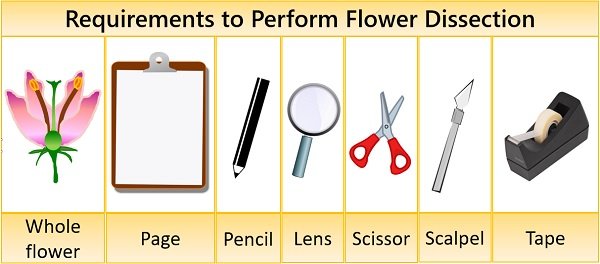
- A whole flower
- Paper
- Marker/Pen/ Pencil
- Cutting devices (scalpel and scissor)
- Tape
Flower Dissection Steps
Let us discuss the steps to dissect a flower.
Step 1. Selection of Flower
First, you need to go out in the yard or to the florist. Then, choose a blossom to cut up. You can pluck or buy two or three different flowers to study the diversity. Lilies, china rose, and poppies are considered ideal for dissection, as identifying floral parts is easy. Here, we will explain the dissection of China rose and pink lily.
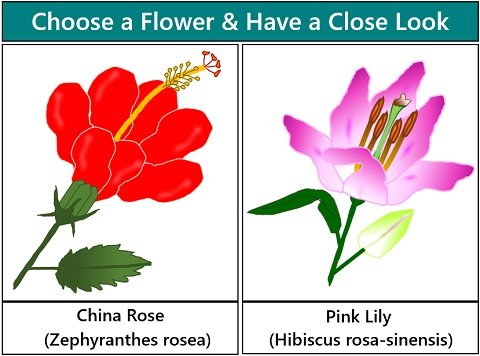
Note: Make sure you select a perfect flower with defined parts.
Step 2. Have a Close Look Into It
In the next step, have a close look at all parts of the flower. You can use a magnifying glass to see the smaller parts even closer.
Note: Meanwhile, take a look at the diagram of flower parts. It will serve as an excellent guide for students to compare and study all flower parts during the dissection.
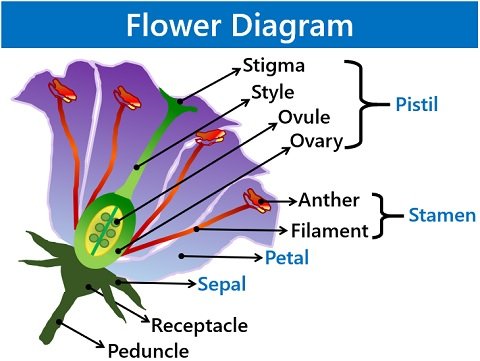
- You must start identifying the parts of a flower from the outside. There, you can see the stalk-like peduncle holding up the flower.
- Above that, you can see the thickened part of the stem called the thalamus or receptacle. From this region, all the floral parts grow.
- The flower’s outermost whorl contains smooth leaf-like sepals. Sepals protect the flower in a developing or budding stage. They either peel back or drop off once the flower blooms, depending on the type of flower.
- Then, you will find bright-coloured petals. Their main job is to attract insects for pollination.
- You may wonder to know that flowers own male and female parts in the innermost whorl. Stamen is the male part of the flower that may present in multiple numbers.
- It has a long stalk-like filament and anther on the top of it.
- Pollens are the structures that give rise to the male gametes or sperm cells.
- The pistil or gynoecium is the female part of the flower.
- It contains a platform-like stigma at the top, which collects pollen.
- Then style is the hollow body between the stigma and ovary. Its principal function is to carry the pollen down to the ovary.
- The pollen fertilizes the flower’s eggs within the flower’s ovary.
Note: Most flowers are perfect, as they have both male and female flowers (like lilies and china rose). But, some flowers are imperfect, as they have either male or female parts (like melons and pumpkins).
Step 3. Preparation Before Dissection
You can use a scissor, scalpel or hands to dissect flowers. You will need a blank piece of paper to display the separated parts of the flowers. In the paper, write on labels using a pen or pencil to show which part of the flower is which.
You can use tape to fix one or all parts next to the box with the part’s name. So, these are the things that you must have before the dissection. Although, paper, scissors and tape are all optional.
But, more it requires is our hands, fingers, and eyes. We can feel the texture and observe floral parts’ different colours and shapes using our sense of touch and vision.
Step 4. Dissection of Sepals
You can start the dissection from the outermost whorl to the innermost one. First, cut the sepals using a scissor. In a china rose, sepals are green coloured. In contrast, the sepals are identical to petals in lily flowers. Sepals and petals in lily flowers are usually present in 3:3 numbers. In the budding stage, pink lilies have greenish sepals protecting the interior parts.
Note: Sepals are the outermost part of the flower, forming calyx.
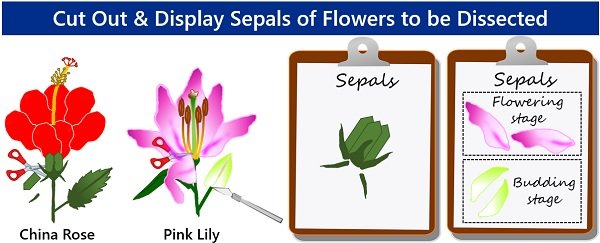
Step 5. Dissection of Petals
Then, cut out the petals using scissors. Also, you can use a magnifying glass to observe the petal’s texture. China-rose flowers have bright-red coloured petals. Pink lilies have beautiful bright-pink coloured petals.
Note: Petals are the second outermost part of the flower, forming corolla.
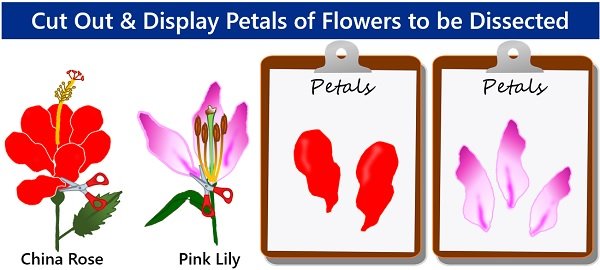
Step 6. Dissection of Stamen
Next, remove the flower’s stamens using a scissor. There you can see a knob-like anther and a slender filament. Then, tap the anther so that the pollens within the anther can come out. You can examine the shape of pollen with your magnifying glass. After you have finished with the pollen, separate all the stamen parts using a scissor.
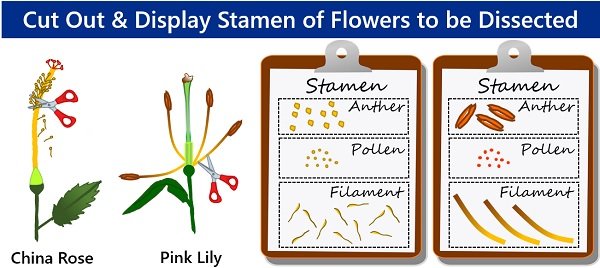
Step7. Dissection of Pistil
Then, lengthwise cut the pistil in half using a sharp scalpel. Style is a long hollow tube, and stigma is the sticky top segment. Dissect each part of the pistil from both the flowers. You can use a magnifying glass to look at the ovules within the ovary.
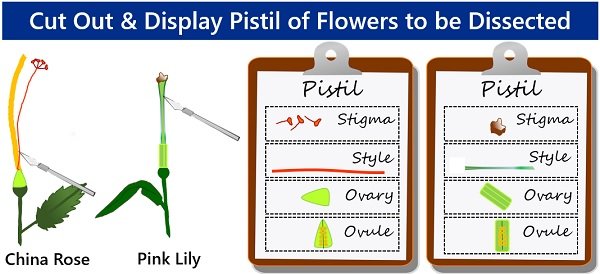
Step8. Dissection of Remaining Parts
Finally, cut out the leaf, stem and thalamus. Although these are not the parts of a flower, they somewhat hold up the flower.
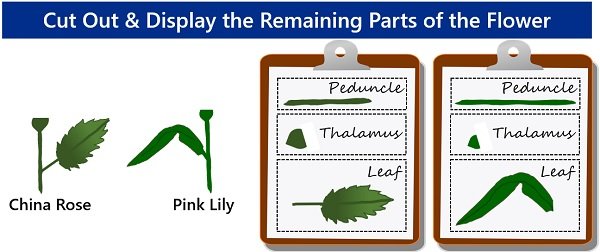
During dissection, you can examine the following things:
- Width and texture of the peduncle
- Parts originating from the receptacle
- Venation pattern in leaves
Significance
First and foremost, flower dissection allows us to distinguish between each floral component. Students could examine the colour and texture of flower parts. As well, they could research how each part of the flower functions. For example, the bright colour of petals attracts pollinators for pollination.
Besides colour and texture, you can identify the plant as either a monocot or a dicot. Here, we have taken china rose and pink lily flowers to dissect. Looking into the number of floral components and leaf venation, we can distinguish between the two.
- Lilies are monocots because floral parts are present in multiples of three and have parallel leaf venations.
- In contrast, china rose is a dicot because floral parts are present in multiples of four or five and have branched leaf venations.
Flower dissection helps students to develop a feeling of gratitude for the beauty that flowers add to this world. After dissection, students will see that flowers vary in colour, scent, and structure. Not all the flowers need to comprise the same floral parts, which we have discussed here.